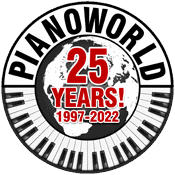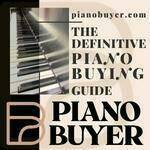Helping You Determine the Value of A Piano – Continued
Page 2
Please note, this article was written back in 2009. While the main points are still valid some of the prices will have changed.
Pre-1930 Pianos Worth Restoring?
A good piano in poor condition is still a poor piano. Conversely, a medium-grade piano in good condition may be the better investment.
The following is a list of piano manufacturers that made highly regarded pianos pre-1930. The reason 1930 is the cut-off point is that during the Great Depression many piano makers, both good and bad, went bankrupt, and their names were bought up by the surviving companies.
In some cases, the defunct company’s design continued to be used, but most of the time, only the name lived on.
This list is from “The Piano Book” by Larry Fine. As Mr. Fine states, this list is not complete , or universally agreed upon, but is merely a guide.
| Steinway Knabe Bösendorfer Ivers & Pond Steinert Emerson Apollo Weber Krakauer Everett Ibach |
Baldwin Chickering Blüthner Henry F. Miller Jewett Vose A.B. Chase Wing Hallet & Davis Hamilton Heintzman |
Mason & Hamlin Bechstein Sohmer McPhail Hume Chas. Stieff Packard Haines Bros. Lester Kimball |
Piano Values
| Please note that it is nearly impossible to determine the value of a piano without seeing it. The values below are for reference only. Your local piano tuner-technician is still your best resource! |
||||
| Description | Low Range |
Average Range |
High Range |
|
| Upright, pre-1930, average worn condition | $ 0 – 100 | $ 200 – 400 | $ 500 – 800 | |
| Upright, pre-1930, better condition (has received minor repair, cleaning,etc.) |
$75-300 | $300-600 | $750-1,000 | |
| Upright, pre-1930, very good condition has received major reconditioning) |
$100-500 | $650-1,050 | $1,000-1800 | |
| Studio, 1930-1950, fair condition | $100-450 | $450-800 | 1,000-1,500 | |
| Studio, 1950-1970, good condition | $300-500 | $600-1,200 | $1,200-1800 | |
| Studio, 1950-1970, very good condition | $500-1,000 | $900-1,450 | $1,500-2200 | |
| Console or spinet, 1930-1950, fair condition | $100-400 | $400-600 | $700-900 | |
| Console or spinet, 1950-1970, good condition | $200-500 | $500-900 | $800-1,200 | |
| Console or spinet, 1950-1970, very good condition | $500-800 | $750-1,300 | $1,100-1,600 | |
| Grand, pre-1930 average brand, average worn condition, 5’+ |
$200-500 | $650-1,300 | $1,200-3,000 | |
| Grand, pre-1930 average brand, average worn condition, 6′ |
$300-500 | $900-1,800 | $2,500-4,000 | |
| Grand, pre-1930, better brand, (e.g. Knabe or Chickering),well maintained, 5’+ |
$600-1,400 | $1,300-2,100 | $3,000-3,500 | |
| Grand, pre-1930, better brand, (e.g. Knabe or Chickering),well maintained, 6′ |
$800-1,500 | $1,650-2,700 | $3,500-4,500 | |
| Grand, 1930-1950, better brand, good condition, 5′ | $800-1,500 | $1,800-2,900 | $4,000-5,000 | |
| Grand, 1930-1950, better brand, good condition, 6′ | $800-1,500 | $2,250-3,550 | $5,000-6,000 | |
| Grand, 1950-1970, mediocre brand, (e.g. Aeolian), good condition, 5′ |
$700-1,100 | $1,200-2,100 | $2,000-3,000 | |
| Grand, 1950-1970, mediocre brand, (e.g. Aeolian), good condition, 6′ |
$800-1,200 | $1,500-2,500 | $2,000-3,000 | |
| Grand, 1950-1970, better brand, very good condition, 5′ |
$1,000-1,800 | $2,200-3,450 | $4,000-6,000 | |
| Grand, 1950-1970, better brand, very good condition, |
$1,000-1,800 | $2,900-4,500 | $5000-7000 | |
| Note: Add 10 to 30 percent (sometimes up to 50 percent) for an “equivalent” piano from a technician instead of a private owner. Steinway pianos usually sell for one-and-a-half to three times (sometimes as much as four) the above prices. |
||||
Piano Depreciation:
Another method of determining the value of a piano is called
the “depreciation” method. This method is especially useful for appraising pianos of recent make when the models are still in production. To use it, one needs to find out how much a new piano of the same or comparable make and model would cost now, and then look up the age of the subject piano on a depreciation schedule.The percentage given represents what the piano is worth relative to the cost of a new one. There is no universally agreed-upon depreciation schedule for pianos, but one such schedule is provided below. This method works fairly well for pianos of average quality which have had a normal amount of wear. For better quality pianos, or pianos that have had either very little or far too much use, the values produced this way must be adjusted accordingly.
| Depreciation Schedule for Pianos | |||
| Age in Years | Percent of New Value | Age in Years | Percent of New Value |
| 1 | 85 | 20 | 43 |
| 2 | 82 | 25 | 34 |
| 3 | 80 | Verticals only: | |
| 5 | 74 | 30 | 27 |
| 8 | 67 | 35 to 70 | 20 |
| 10 | 62 | Grands only: | |
| 15 | 52 | 30 to 70 | 30 |
| Depreciation schedule courtesy of Stephen H. Brady, RPT, Seattle, Washington. Reprinted from – The Piano Book by Larry Fine. |
|||
Back To Piano Value Page 1






Leave a Reply
You must be logged in to post a comment.